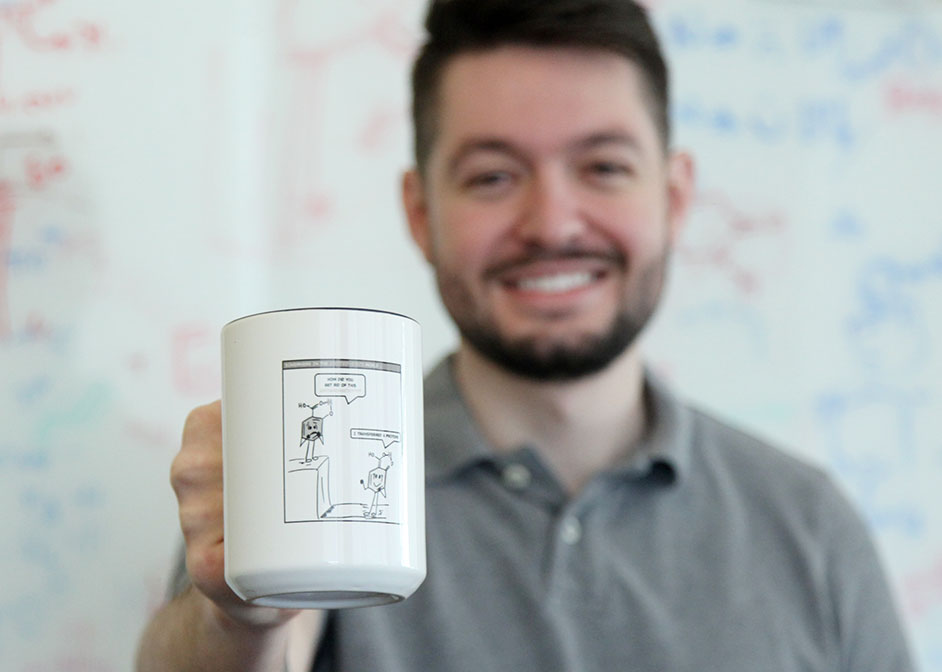Lucas Karas Studies Computational Chemistry with Professor Judy Wu
If you enter Lucas Karas’ office in the Science and Engineering Research Center at the University of Houston, you’ll find the usual items – a computer, books, equations on a chalkboard.

But you may also find cartoon sketches. And if you look closely, you’ll spot one of those sketches printed on Karas’ coffee mug.
The cartoon illustrates why some molecules undergo proton transfer reactions when exposed to radiation by light. Excited-state proton transfer reactions are one of the most important classes of photochemical reactions, relevant to energy transfer, photosynthesis and many other important chemical and biological processes.
Karas uses computer simulations to study photochemical processes under the advisement of College of Natural Sciences and Mathematics assistant professor Judy Wu. Because the work can be difficult to explain and teach, Karas drew the cartoon, and draws others, to make his research more understandable.
He got the inspiration from an Instagram account he follows that draws cartoons of chemical reactions.
“I just had this idea – that it would be nice to draw my research,” he said. “Because when you draw a picture to show a scientific finding, you are forced to distill the idea to its core. These drawings make it easier for other people to appreciate the importance of our finding.”
Publication in PNAS
Karas would have liked to include the cartoon in his latest publication as a student lead author in Proceedings of the National Academy of Sciences in October. However, he said, the publication does not allow graphical representations.

He joined Wu, postdoctoral researcher Chia-Hu Wu and Uppsala University professor Henrik Ottosson as co-authors of the publication on excited-state proton transfer and how it relieves antiaromaticity in molecules.
Regarding his work in the photostability of molecules, Karas explains that when light shines on an aromatic molecule, it goes to an excited state becoming “antiaromatic” and unstable. The molecule can become stable again by transferring a proton and relieving its antiaromatic character.
Karas adds he has a publication under review in Angewandte Chemie International Edition. Only this time, the article focuses on proton and electron transfer reactions in the photoexcited states of DNA base pairs. The article is online as a pre-print on ChemRxiv.
“What we found is that there’s a relationship between a molecule being photoexcited and becoming excited-state antiaromatic,” said Karas. “Proton and electron transfer reactions provide a channel for molecules in the excited-state to relieve antiaromaticity, and this underlies the photostability of DNA base pairs.”
Karas said their findings could be used to make novel artificial base pairs that are photostable. Researchers have recently made breakthroughs in artificial DNA base pairs that show synthetic DNA appears to behave like natural DNA. Karas’ work could contribute to future findings.
Computational Chemistry Brings Significant Funding
Wu said Karas is the type of student that encourages her to be a better advisor because of his growth in scientific maturity and his appreciation of the work that goes into earning a Ph.D.

“He pays attention to learning how to write better, how to communicate better, how to think better,” she said. “I enjoy working with him especially, not just because he works hard. Lucas works smart, and he thinks deeply about problems. He often surprises me with what he finds and what he thinks about research.”
The Wu group’s extensive work in computational organic chemistry earned them a $1.8 million Maximizing Investigators’ Research Award from the National Institutes of Health last fall, which provided the group with more resources.

Karas said it is also Wu’s advisement and engagement that has made the group so successful.
“Dr. Wu encourages us to be better in all aspects of science,” he said. “She is trying to make me not just a better researcher, but also a better writer and presenter. I think that’s something that can make a big difference for my future career development.”
He adds that Wu motivates the group and puts a lot of effort into helping them become better thinkers.
Before applying to UH, Karas knew he wanted to work with Wu because of her research and achievements.
He is working to become a computational chemistry professor and plans on graduating in two or two and a half years.
- Rebeca Trejo, College of Natural Sciences and Mathematics